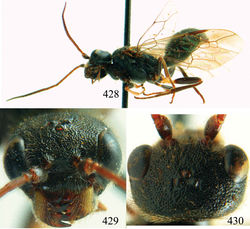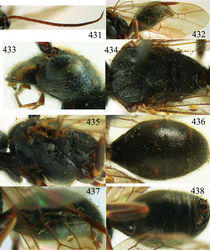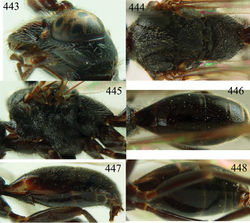Taeniogonalos maga
| Notice: | This page is derived from the original publication listed below, whose author(s) should always be credited. Further contributors may edit and improve the content of this page and, consequently, need to be credited as well (see page history). Any assessment of factual correctness requires a careful review of the original article as well as of subsequent contributions.
If you are uncertain whether your planned contribution is correct or not, we suggest that you use the associated discussion page instead of editing the page directly. This page should be cited as follows (rationale):
Citation formats to copy and paste
BibTeX: @article{Chen2014ZooKeys385, RIS/ Endnote: TY - JOUR Wikipedia/ Citizendium: <ref name="Chen2014ZooKeys385">{{Citation See also the citation download page at the journal. |
Ordo: Hymenoptera
Familia: Trigonalyidae
Genus: Taeniogonalos
Name
Taeniogonalos maga (Teranishi, 1929) – Wikispecies link – Pensoft Profile
- Poecilogonalos maga Teranishi, 1929: 148; Marshakov 1981[1]: 106; Tsuneki 1991[2]: 51; Weinstein and Austin 1991[3]: 423; Lelej 1995[4]: 14.
- Taeniogonalos maga; Carmean and Kimsey 1998[5]: 68; Bennett and Lelej 2003[6]: 8; Li et al. 2012[7]: 4.
- Taiwanogonalos alishana Tsuneki, 1991: 36. Synonymized by Carmean and Kimsey 1998[5] with Taeniogonalos maga.
- Taiwanogonalos claripennis Tsuneki, 1991: 38. Synonymized by Carmean and Kimsey 1998[5] with Taeniogonalos maga.
Type material
Holotype of Poecilogonalos maga, > (OMNH), “[Japan:], Nagano, Shimajima, VII.1927, K. Sato”, “Holotype Poecilogonalos maga”; 1 paratype, + (OMNH), topotypic and same date, “Allotype Poecilogonalos magae”. Holotype of Taeniogonalos alishana, > (OMNH), “[China:], Taiwan, Arisan, 27.V.1929, K. Sato”, “Holotype P. maga arisana” [MS label by C. Teranishi], “Taiwanogonalos alishana Tsuneki, >, holotype”.
Additional material
1 + (ZJUH) “[China:] Zhejiang, Mt. Tianmu, 18.VI.1983, Yun Ma, 831378”; 1 + + 7 > (ZJUH, RMNH) “[China:] Zhejiang, Mt. Tianmu, Xianrending, 1509 m, 14.VII.1998, MT, Ming-shui Zhao, 200010683, 200010684, 200010687; id., but 20.VII.1998, 992748, 992753; id., but 23.VII.1998, 200010697; id., but 28.VII.2003, Xiao-xia Yu, 20034472; id., but 2–4.VI.1990, Zu-hua Shi, 901559; id., but Yong-gen Lou, 900463”.
Diagnosis
Outer side of supra-antennal elevations oblique and elevations 0.4–0.5 times as long as scapus (Fig. 430); occipital carina moderately widened medio-dorsally (near weak medio-posterior depression of vertex up to 0.5 times as wide as diameter of ocellus; Fig. 430); anteriorly vertex of + often partly coarsely punctate and smooth interspaces partly narrower than diameter of punctures; head posteriorly entirely black (Fig. 430); mesosoma of both sexes black dorsally and coarsely sculptured (Fig. 434); marginal cell of fore wing with brown patch (Fig. 432); second sternite of female distinctly convex, of male with shallow depressed subposterior area (Fig. 438); third sternite of male slightly convex or flat subposteriorly; third sternite 0.2-0.3 times as long as second sternite.
Description
Holotype, male, length of body 8.7 mm (of fore wing 7.8 mm).
Head. Antenna with 23 segments with longitudinal tyloids on 10th-14th segments; frons densely coarsely punctate (interspaces less than width of punctures) and with some rugae anteriorly; vertex coarsely punctate (Fig. 430), with medium-sized setae; temple spaced punctate (Fig. 433); head gradually narrowed behind eyes, eye in dorsal view as long as temple (Fig. 430); occipital carina moderately widened medio-dorsally (near weak medio-posterior depression of vertex up to 0.5 times as wide as diameter of ocellus; Fig. 430); with few weak crenulae dorsally; supra-antennal elevations medium-sized (about 0.5 times as long as scapus) and their outer side rather steeply oblique (Fig. 430); clypeus weakly concave and thick medio-ventrally.
Mesosoma. Length of mesosoma 1.4 times its height (Fig. 435); transverse mesopleural groove moderately wide, deep and coarsely crenulate; mesopleuron reticulate-rugose (antero-dorsally more coarsely so), but speculum smooth and shiny; notauli moderately narrow, deep and sparsely crenulate; middle lobe of mesoscutum coarsely vermiculate rugose, lateral lobes more spaced rugose (Fig. 434); scutellar sulcus complete, medium-sized and crenulate medially and wider laterally; scutellum densely rugose, rather flat anteriorly and slightly above level of mesoscutum, but rather longitudinally depressed medially; metanotum medially distinctly convex, moderately protruding and rugose (Fig. 434); propodeum entirely vermiculate-rugose or nearly so (Fig. 434); posterior propodeal carina rather wide lamelliform and distinctly arched, foramen about 1.3 times as wide basally as high medially.
Wings. Fore wing: length of vein 1-M 1.6 times as long as vein 1-SR (Fig. 432).
Metasoma. First tergite 0.6 times as long as apically wide, largely smooth and with distinct wide depression medially (Fig. 436); second and following tergites densely superficially punctate and shiny (Fig. 436); sternites rather coarsely and densely punctate; second sternite weakly convex in lateral view (Fig. 437); third sternite 0.3 times as long as second sternite; second sternite slightly depressed medio-posteriorly (Fig. 438); third sternite flat medio-posteriorly.
Colour. Black; mandible medially, apices of fore and middle trochanters, hind trochanter and trochantellus and bases of femora largely ivory; second tergite with indistinct pair of small brownish patches posteriorly (Fig. 436); antenna (but darkened basally), palpi and tegulae mainly brown; fore tibia and tarsus, middle tibia basally brownish-yellow and remainder of legs dark brown; subapical patch of fore wing infuscate; pterostigma and veins brown, remainder of wing membrane subhyaline.
Variation. Length of body 7.0–8.7 mm, of fore wing 6.8–7.8 mm; antenna of > with 22 (1), 23 (1) or 24 (1) segments, with linear tyloids on (9th–)10th–14th(–15th) segments; second tergite black, ivory or yellowish latero-posteriorly, propodeum coarsely to superficially sculptured.
Female. Female paratype is very similar to holotype, but brown patch of fore wing larger and darker, first metasomal tergite with pair of ivory patches apically, and second tergite with pair of large ivory patches latero-posteriorly; length of body 9.0 mm and of fore wing 8.8 mm.
Biology
Unknown (record for Taeniogonalos maga concerns Taeniogonalos taihorina). Collected in May–July, up to 1509 m.
Distribution
China (Taiwan, Zhejiang); Japan (Honshu). Other records of this species need reconfirmation.
Taxon Treatment
- Chen, H; van Achterberg, C; He, J; Xu, Z; 2014: A revision of the Chinese Trigonalyidae (Hymenoptera, Trigonalyoidea) ZooKeys, 385: 1-207. doi
Other References
- ↑ Marshakov V (1981) [Trigonalidae (Hymenoptera) of the USSR fauna]. In: Korotyaev B (Ed) Morfologia i sistematica nasekomykh Dalnego Vostoka [Morphology and Systematics of insects of the Far East]. Nauka, Leningrad 92: 100–107. [in Russian]
- ↑ Tsuneki K (1991) Revision of the Trigonalidae of Japan and adjacent territories (Hymenoptera). Special Publications Japan Hymenopterists Association 37: 1-68.
- ↑ Weinstein P, Austin A (1991) The host relationships of trigonalyid wasps (Hymenoptera: Trigonalyidae), with a review of their biology and catalogue to world species. Journal of Natural History 25(2): 399–433. doi: 10.1080/00222939100770281
- ↑ Lelej A (1995) [Fam. Trigonalidae - Trigonalid wasps]. In: Kupianskaya A Lelej A Storozheva N (Eds) [Key to the insects of Russian Far East] IV(2): 8–14. [in Russian]
- ↑ 5.0 5.1 5.2 Carmean D, Kimsey L (1998) Phylogenetic revision of the parasitoid wasp family Trigonalidae (Hymenoptera). Systematic Entomology 23: 35–76. doi: 10.1046/j.1365-3113.1998.00042.x
- ↑ Bennett D, Lelej A (2003) To the knowledge of trigonalyid wasps (Hymenoptera: Trigonalyidae) of Sakhalin. Far Eastern Entomologist N 130: 8.
- ↑ Li T, Sheng M, Sun S, Luo Y (2012) Parasitoids of the sawfly, Arge pullata, in the Shennongjia National Nature Reserve. Journal of Insect Science 12(97): 1–9. http://www.insectscience.org/12.97 doi: 10.1673/031.012.9701
Images
|



